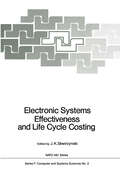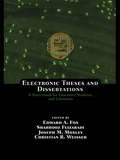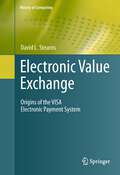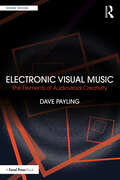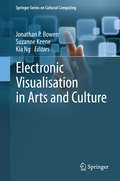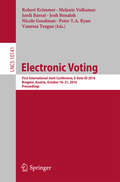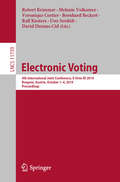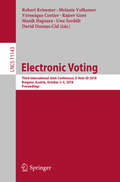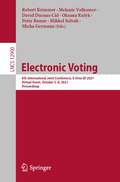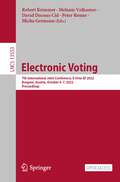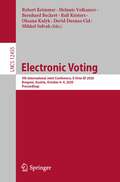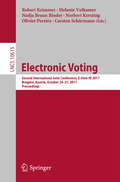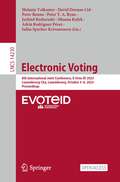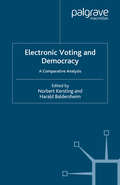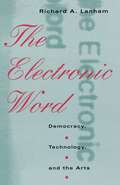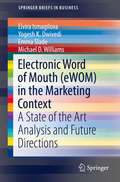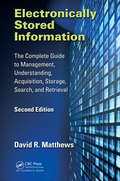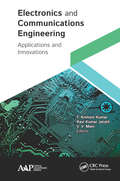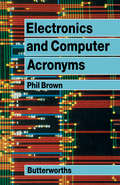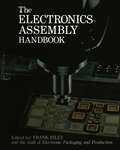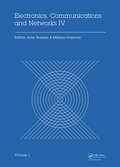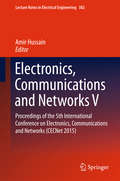- Table View
- List View
Electronic Systems Effectiveness and Life Cycle Costing (NATO ASI Subseries F: #3)
by J. K. SkwirzynskiThis volume contains the complete proceedings of a NATO Advanced Study Institute on various aspects of the reliability of electronic and other systems. The aim of the Insti~ute was to bring together specialists in this subject. An important outcome of this Conference, as many of the delegates have pointed out to me, was complementing theoretical concepts and practical applications in both software and hardware. The reader will find papers on the mathematical background, on reliability problems in establishments where system failure may be hazardous, on reliability assessment in mechanical systems, and also on life cycle cost models and spares allocation. The proceedings contain the texts of all the lectures delivered and also verbatim accounts of panel discussions on subjects chosen from a wide range of important issues. In this introduction I will give a short account of each contribution, stressing what I feel are the most interesting topics introduced by a lecturer or a panel member. To visualise better the extent and structure. of the Institute, I present a tree-like diagram showing the subjects which my co-directors and I would have wished to include in our deliberations (Figures 1 and 2). The names of our lecturers appear underlined under suitable headings. It can be seen that we have managed to cover most of the issues which seemed important to us. VI SYSTEM EFFECTIVENESS _---~-I~--_- Performance Safety Reliability ~intenance ~istic Lethality Hazards Support S.N.R. JARDINE Max. Vel. etc.
Electronic Theses and Dissertations: A Sourcebook for Educators: Students, and Librarians (Books In Library And Information Science Ser. #Vol. 65)
by Edward A.Fox Shahrooz Feizabadi Joseph M. Moxley Christian R. WeisserElectronic Theses and Dissertations examines how electronic publication of theses and dissertations might enhance graduate education. This text clarifies the composition, evaluation, dissemination, and preservation of electronic theses and dissertations (ETDs), and provides a conceptual framework for the development of effective ETD programs. It id
Electronic Value Exchange: Origins of the VISA Electronic Payment System (History of Computing)
by David L. StearnsElectronic Value Exchange examines in detail the transformation of the VISA electronic payment system from a collection of non-integrated, localized, paper-based bank credit card programs into the cooperative, global, electronic value exchange network it is today. Topics and features: provides a history of the VISA system from the mid-1960s to the early 1980s; presents a historical narrative based on research gathered from personal documents and interviews with key actors; investigates, for the first time, both the technological and social infrastructures necessary for the VISA system to operate; supplies a detailed case study, highlighting the mutual shaping of technology and social relations, and the influence that earlier information processing practices have on the way firms adopt computers and telecommunications; examines how “gateways” in transactional networks can reinforce or undermine established social boundaries, and reviews the establishment of trust in new payment devices.
Electronic Visual Music: The Elements of Audiovisual Creativity (Sound Design)
by Dave PaylingElectronic Visual Music is a comprehensive guide to the composition and performance of visual music, and an essential text for those wanting to explore the history, current practice, performance strategies, compositional methodologies and practical techniques for conceiving and creating electronic visual music. Beginning with historical perspectives to inspire the reader to work creatively and develop their own individual style, visual music theory is then discussed in an accessible form, providing a series of strategies for implementing ideas. Including interviews with current practitioners, Electronic Visual Music provides insight into contemporary working methods and gives a snapshot of the state of the art in this ever-evolving creative discipline. This book is a valuable resource for artists and practitioners, as well as students, educators and researchers working in disciplines such as music composition, music production, video arts, animation and related media arts, who are interested in informing their own work and learning new strategies and techniques for exploration and creative expression of electronic visual music.
Electronic Visual Music: The Elements of Audiovisual Creativity (Sound Design)
by Dave PaylingElectronic Visual Music is a comprehensive guide to the composition and performance of visual music, and an essential text for those wanting to explore the history, current practice, performance strategies, compositional methodologies and practical techniques for conceiving and creating electronic visual music. Beginning with historical perspectives to inspire the reader to work creatively and develop their own individual style, visual music theory is then discussed in an accessible form, providing a series of strategies for implementing ideas. Including interviews with current practitioners, Electronic Visual Music provides insight into contemporary working methods and gives a snapshot of the state of the art in this ever-evolving creative discipline. This book is a valuable resource for artists and practitioners, as well as students, educators and researchers working in disciplines such as music composition, music production, video arts, animation and related media arts, who are interested in informing their own work and learning new strategies and techniques for exploration and creative expression of electronic visual music.
Electronic Visualisation in Arts and Culture (Springer Series on Cultural Computing)
by Jonathan P. Bowen, Suzanne Keene and Kia NgPresenting the latest technological developments in arts and culture, this volume demonstrates the advantages of a union between art and science. Electronic Visualisation in Arts and Culture is presented in five parts:Imaging and CultureNew Art PracticeSeeing MotionInteraction and Interfaces Visualising HeritageElectronic Visualisation in Arts and Culture explores a variety of new theory and technologies, including devices and techniques for motion capture for music and performance, advanced photographic techniques, computer generated images derived from different sources, game engine software, airflow to capture the motions of bird flight and low-altitude imagery from airborne devices.The international authors of this book are practising experts from universities, art practices and organisations, research centres and independent research. They describe electronic visualisation used for such diverse aspects of culture as airborne imagery, computer generated art based on the autoimmune system, motion capture for music and for sign language, the visualisation of time and the long term preservation of these materials. Selected from the EVA London conferences from 2009-2012, held in association with the Computer Arts Society of the British Computer Society, the authors have reviewed, extended and fully updated their work for this state-of-the-art volume.
Electronic Voting: First International Joint Conference, E-Vote-ID 2016, Bregenz, Austria, October 18-21, 2016, Proceedings (Lecture Notes in Computer Science #10141)
by Robert Krimmer Melanie Volkamer Jordi Barrat Josh Benaloh Nicole Goodman Peter Y. Ryan Vanessa TeagueThis book constitutes the thoroughly refereed conference proceedings of the First International Joint Conference on Electronic Voting, E-Vote-ID 2016, held in Bregenz, Austria, in October 2016. The 14 full papers presented were carefully reviewed and selected from 57 submissions. They represent a wide range of technological proposals for different voting settings (be it in polling stations, remote voting or even mobile voting) and case studies from different countries already using electronic voting or having conducted first trial elections.
Electronic Voting: 4th International Joint Conference, E-Vote-ID 2019, Bregenz, Austria, October 1–4, 2019, Proceedings (Lecture Notes in Computer Science #11759)
by Robert Krimmer Melanie Volkamer Veronique Cortier Bernhard Beckert Ralf Küsters Uwe Serdült David Duenas-CidThis book constitutes the proceedings of the 4th International Conference on Electronic Voting, E-Vote-ID 2019, held in Bregenz, Austria, in October 2019. The 13 revised full papers presented were carefully reviewed and selected from 45 submissions. The conference was organized in tracks on security, usability and technical issues, administrative, legal, political and social issues, elections and practical experiences, posters and e-voting system demo.
Electronic Voting: Third International Joint Conference, E-Vote-ID 2018, Bregenz, Austria, October 2-5, 2018, Proceedings (Lecture Notes in Computer Science #11143)
by Robert Krimmer Melanie Volkamer Véronique Cortier Rajeev Goré Manik Hapsara Uwe Serdült David Duenas-CidThis book constitutes the refereed proceedings of the Third International Joint Conference on Electronic Voting, E-Vote-ID 2018, held in Bregenz, Austria, in October 2018. The 13 full papers presented in this volume were carefully reviewed and selected from 45 submissions. The papers deal with topics connected with electronic voting including experiences and revisions of the real uses of E-voting systems and corresponding processes in elections.
Electronic Voting: 6th International Joint Conference, E-Vote-ID 2021, Virtual Event, October 5–8, 2021, Proceedings (Lecture Notes in Computer Science #12900)
by Robert Krimmer Melanie Volkamer David Duenas-Cid Oksana Kulyk Peter Rønne Mihkel Solvak Micha GermannThis book constitutes the proceedings of the 6th International Conference on Electronic Voting, E-Vote-ID 2021, held online -due to COVID -19- in Bregenz, Austria, in October 2021. The 14 full papers presented were carefully reviewed and selected from 55 submissions. The conference collected the most relevant debates on the development of Electronic Voting, from aspects relating to security and usability through to practical experiences and applications of voting systems, as well as legal, social or political aspects.
Electronic Voting: 7th International Joint Conference, E-Vote-ID 2022, Bregenz, Austria, October 4–7, 2022, Proceedings (Lecture Notes in Computer Science #13553)
by Robert Krimmer Melanie Volkamer David Duenas-Cid Peter Rønne Micha GermannThis open access book LNCS 13353 constitutes the proceedings of the 7th International Conference on Electronic Voting, E-Vote-ID 2022, held in Bregenz, Austria, in October 2022. The 10 full papers presented were carefully reviewed and selected from 39 submissions. The conference collected the most relevant debates on the development of Electronic Voting, from aspects relating to security and usability through to practical experiences and applications of voting systems, also including legal, social, or political aspects, amongst others.
Electronic Voting: 5th International Joint Conference, E-Vote-ID 2020, Bregenz, Austria, October 6–9, 2020, Proceedings (Lecture Notes in Computer Science #12455)
by Robert Krimmer Melanie Volkamer Ralf Küsters David Duenas-Cid Bernhard Beckert Oksana Kulyk Mikhel SolvakThis book constitutes the proceedings of the 5th International Conference on Electronic Voting, E-Vote-ID 2020, held online -due to COVID -19- in Bregenz, Austria, in October 2020. The 14 full papers presented were carefully reviewed and selected from 55 submissions.The conference collected the most relevant debates on the development of Electronic Voting, from aspects relating to security and usability through to practical experiences and applications of voting systems, also including legal, social or political aspects, amongst others; turning out to be an important global referent in relation to this issue.
Electronic Voting: Second International Joint Conference, E-Vote-ID 2017, Bregenz, Austria, October 24-27, 2017, Proceedings (Lecture Notes in Computer Science #10615)
by Robert Krimmer, Melanie Volkamer, Nadja Braun Binder, Norbert Kersting, Olivier Pereira and Carsten SchürmannThis book constitutes the refereed proceedings of the Second International Joint Conference on Electronic Voting, E-Vote-ID 2017, held in Bregenz, Austria, in October 2017.The 16 full papers presented in this volume were carefully reviewed and selected from 48 submissions. In addition the book contains 3 keynote talks. The papers deal with security, usability and technical issues; administrative, legal, political and social issued; and election and practical experiences.
Electronic Voting: 8th International Joint Conference, E-Vote-ID 2023, Luxembourg City, Luxembourg, October 3–6, 2023, Proceedings (Lecture Notes in Computer Science #14230)
by Melanie Volkamer David Duenas-Cid Peter Rønne Peter Y. A. Ryan Jurlind Budurushi Oksana Kulyk Adrià Rodriguez Pérez Iuliia Spycher-KrivonosovaThis open access book constitutes the proceedings of the 8th International Joint Conference on Electronic Voting held in Luxemburg in October 2023. The conference collected the most relevant debates on the development of Electronic Voting, from aspects relating to security and usability through to practical experiences and applications of voting systems, also including legal, social, or political aspects, amongst others. The 9 full papers presented were carefully reviewed and selected from 38 submissions. The selected papers cover a wide range of topics connected with electronic voting, including experiences and revisions of the actual uses of E-voting systems and corresponding processes in elections.
Electronic Voting and Democracy: A Comparative Analysis
by N. Kersting H. BaldersheimElectronic and internet voting has become increasingly widespread in recent years, but which countries are the leaders of the movement and who lags behind? Is the digital divide likely to present a permanent challenge to electronic democracy? What are the experiences with regard to online voting, and what are the arguments for and against? Electronic Voting and Democracy examines these issues and the contexts in which they are played out, such as problems of legitimacy and the practical considerations that have driven some countries toward electronic voting faster than others.
The Electronic Word: Democracy, Technology, and the Arts
by Richard A. LanhamThe personal computer has revolutionized communication, and digitized text has introduced a radically new medium of expression. Interactive, volatile, mixing word and image, the electronic word challenges our assumptions about the shape of culture itself. This highly acclaimed collection of Richard Lanham's witty, provocative, and engaging essays surveys the effects of electronic text on the arts and letters. Lanham explores how electronic text fulfills the expressive agenda of twentieth-century visual art and music, revolutionizes the curriculum, democratizes the instruments of art, and poses anew the cultural accountability of humanism itself. Persuading us with uncommon grace and power that the move from book to screen gives cause for optimism, not despair, Lanham proclaims that "electronic expression has come not to destroy the Western arts but to fulfill them." The Electronic Word is also available as a Chicago Expanded Book for your Macintosh®. This hypertext edition allows readers to move freely through the text, marking "pages," annotating passages, searching words and phrases, and immediately accessing annotations, which have been enhanced for this edition. In a special prefatory essay, Lanham introduces the features of this electronic edition and gives a vividly applied critique of this dynamic new edition.
Electronic Word of Mouth: A State of the Art Analysis and Future Directions (SpringerBriefs in Business)
by Elvira Ismagilova Yogesh K. Dwivedi Emma Slade Michael D. WilliamsThis SpringerBrief offers a state of the art analysis of electronic word-of-mouth (eWOM) communications and its role in marketing. The book begins with an overview of traditional word-of-mouth (WOM) and its evolution to eWOM. It discusses the differences between traditional and online WOM. The book examines why people engage in eWOM communications, but also how consumers evaluate its persuasiveness. It also looks at the effects of eWOM. The book identifies current gaps in the eWOM research, but also highlights future directions for this growing field. eWOM is an important marketing technique in brand communications, and it plays an important role in modern e-commerce. Marketers become extremely interested in enhancing the power of eWOM developing loyalty programs and building brands. Studying the effect of eWOM can be beneficial for companies. This book should be a good resource for scholars and practitioners that need to understand the pervasive effects of eWOM.
Electronically Stored Information: The Complete Guide to Management, Understanding, Acquisition, Storage, Search, and Retrieval, Second Edition
by David R. MatthewsAlthough we live in an era in which we are surrounded by an ever-deepening fog of data, few of us truly understand how the data are created, where data are stored, or how to retrieve or destroy data—if that is indeed possible. This book is for all of you, whatever your need or interest.Electronically Stored Information: The Complete Guide to Management, Understanding, Acquisition, Storage, Search, and Retrieval, Second Edition explains the reasons you need to know about electronic data. It also gets into great detail about the how, what, when, and where of what is known in legal circles as electronically stored information (ESI).With easy-to-understand explanations and guidelines, this book provides the practical understanding you need to effectively manage the complex world of ESI. Whether you are an attorney, judge, paralegal, business manager or owner, or just one of the ever-growing population of computer users, you will benefit from the information presented in this book.
Electronically Stored Information: The Complete Guide to Management, Understanding, Acquisition, Storage, Search, and Retrieval, Second Edition
by David R. MatthewsAlthough we live in an era in which we are surrounded by an ever-deepening fog of data, few of us truly understand how the data are created, where data are stored, or how to retrieve or destroy data—if that is indeed possible. This book is for all of you, whatever your need or interest.Electronically Stored Information: The Complete Guide to Management, Understanding, Acquisition, Storage, Search, and Retrieval, Second Edition explains the reasons you need to know about electronic data. It also gets into great detail about the how, what, when, and where of what is known in legal circles as electronically stored information (ESI).With easy-to-understand explanations and guidelines, this book provides the practical understanding you need to effectively manage the complex world of ESI. Whether you are an attorney, judge, paralegal, business manager or owner, or just one of the ever-growing population of computer users, you will benefit from the information presented in this book.
Electronics and Communications Engineering: Applications and Innovations
by T. Kishore Kumar Ravi Kumar Jatoth V. V. ManiEvery day, millions of people are unaware of the amazing processes that take place when using their phones, connecting to broadband internet, watching television, or even the most basic action of flipping on a light switch. Advances are being continually made in not only the transmission of this data but also in the new methods of receiving it. These advancements come from many different sources and from engineers who have engaged in research, design, development, and implementation of electronic equipment used in communications systems. This volume addresses a selection of important current advancements in the electronics and communications engineering fields, focusing on signal processing, chip design, and networking technology. The sections in the book cover: Microwave and antennas Communications systems Very large-scale integration Embedded systems Intelligent control and signal processing systems
Electronics and Communications Engineering: Applications and Innovations
Every day, millions of people are unaware of the amazing processes that take place when using their phones, connecting to broadband internet, watching television, or even the most basic action of flipping on a light switch. Advances are being continually made in not only the transmission of this data but also in the new methods of receiving it. These advancements come from many different sources and from engineers who have engaged in research, design, development, and implementation of electronic equipment used in communications systems. This volume addresses a selection of important current advancements in the electronics and communications engineering fields, focusing on signal processing, chip design, and networking technology. The sections in the book cover: Microwave and antennas Communications systems Very large-scale integration Embedded systems Intelligent control and signal processing systems
Electronics and Computer Acronyms
by Phil BrownElectronics and Computer Acronyms presents a list of almost 2,500 acronyms related to electronics and computers. The material for this book is drawn from a number of subject areas, including electrical, electronics, computers, telecommunications, fiber optics, microcomputers/microprocessors, audio, video, and information technology. The acronyms also encompass avionics, military, data processing, instrumentation, units, measurement, standards, services, organizations, associations, and companies. This dictionary offers a comprehensive and broad view of electronics and all that is associated with it. Cross-references are provided in the form of abbreviations within parentheses. For example, the entry for CCD, charge-coupled device, provides three cross-references: charge-transfer device (CTD), metal-oxide semiconductor (MOS), and capacitor (C,6). To broaden further the explanation, if required, referral to entries CTD, MOS, and C part 6 (C is a multiple entry with 10 parts) is advised. The system of prefixes and units used in the Système International d'Unités is followed throughout the book. This monograph is intended for students, engineers, and technicians as well as those with an interest in computers and electronics.
The Electronics Assembly Handbook
by Frank Riley Electronic Packaging Electronic Packaging A ProductionThe assembly of electronic circuit boards has emerged as one of the most significant growth areas for robotics and automated assembly. This comprehensive volume, which is an edited collection of material mostly published in "Assembly Engineering" and "Electronic Packaging and Production", will provide an essential reference for engineers working in this field, including material on Multi Layer Boards, Chip-on-board and numerous case studies. Frank J. Riley is senior vice-president of the Bodine Corporation and a world authority on assembly automation.
Electronics, Communications and Networks IV: Proceedings of the 4th International Conference on Electronics, Communications and Networks (CECNET IV), Beijing, China, 12�15 December 2014
by Amir Hussain Mirjana IvanovicThe 4th International Conference on Electronic, Communications and Networks (CECNet2014) inherits the fruitfulness of the past three conferences and lays a foundation for the forthcoming next year in Shanghai. CECNet2014 was hosted by Hubei University of Science and Technology, China, with the main objective of providing a comprehensive global foru
Electronics, Communications and Networks V: Proceedings of the 5th International Conference on Electronics, Communications and Networks (CECNet 2015) (Lecture Notes in Electrical Engineering #382)
by Amir HussainThis book comprises peer-reviewed contributions presented at the 5th International Conference on Electronics, Communications and Networks (CECNet 2015), held in Shanghai, China, 12-15 December, 2015. It includes new multi-disciplinary topics spanning a unique depth and breadth of cutting-edge research areas in Electronic Engineering, Communications and Networks, and Computer Technology. More generally, it is of interest to academics, students and professionals involved in Consumer Electronics Technology, Communication Engineering and Technology, Wireless Communication Systems and Technology, and Computer Engineering and Technology.
